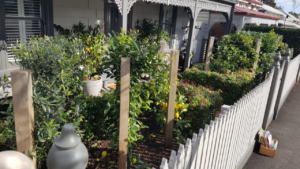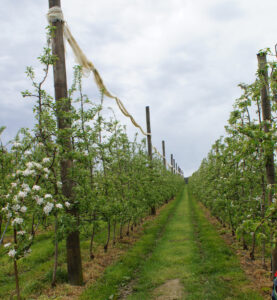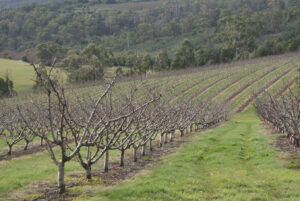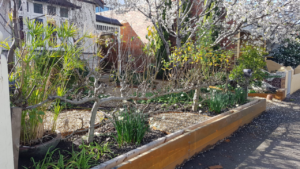
(Mary Mary quite contrary…) How do your fruit trees grow?
By John Fitzsimmons
Depending on your age and experience, the ways you perceive how fruit is grown could be extremely different. Today’s commercial orchards are radically different spaces to nostalgic visions of broad canopies of vase-pruned trees, modest fruit yields and long-term expectations, yet there are many contemporary commercial trends that could be applied to advantage in modern landscapes involving edibles, even in small spaces.
Once upon a time, as the story goes, fruit orchards, especially of apples and pears, were places of low tree density, perhaps just 250 trees per acre (in the ‘old money’), with vase-pruned trees at wide inter-row and intra-row spacings. They were also often regarded as long-term propositions, commercially breaking even in maybe 7-10 years and expected to stay in production for 20 years or more. The range of varieties grown was also relatively small and stable, perhaps a dozen or so, although some notable collections hold, or have recorded, up to 200 or 300 varieties.

Around the 1970s, the landscape literally changed with the wider uptake of trellising systems, including the locally developed Tatura Trellis, a ‘V’-form approach and tree densities increased significantly. Over the last 10-20 years orchards have changed even more dramatically, driven largely by a need for much greater productivity and better commercial returns on investments. This has been achieved by improved varietal selections matched with appropriate rootstocks, significantly higher tree densities (4000 trees/ha or more is not uncommon), and new training and pruning systems that still ‘harvest light’ efficiently while encouraging the trees to produce a lot of fruit. Especially in apples, pears and summer fruits, there is now an amazing range of new varietal selections and hybrids to meet wider horticultural, visual (market appeal) and culinary needs. Many are ‘club’ varieties for which propagation, growing and marketing is licensed and closely managed. For more information talk to your specialist propagation nursery.


In combination, these trends have dramatically increased fruit yields (per hectare), improved ‘packout’ (less wastage of fruit harvested) and, notably, often reduced labour requirements. The last point has been greatly influenced by OH&S trends, e.g., eliminating use of ladders, such that most orchard operations are now conducted from ground level.

Those trends can also be applied to advantage in our horticultural landscapes. There is an intersection of objectives and preferences with more available options. The trees are smaller which are ideal for contemporary smaller areas. Tree density can be dramatically increased, almost to hedging intensity. A common theme across many contemporary trellising systems, is the ‘fruit wall’ and ‘2-dimensional’ approach that is a useful concept for home garden settings.
Of course, the ultimate crossover is ‘greater productivity’ with ‘edibles’, one of the biggest trends in domestic horticulture. What’s not to like?

Well, yes, there are higher levels of tree management required to achieve the desired outcome, and it’s certainly more involved and technically challenging for the home gardener than maintaining a well-trimmed hedge.
However, there is a large and growing population of home gardeners who are keen and actively involved in deeper learning about specialist niches, and who are also interested in going up to a new level or beyond, into a new dimension.

This is also an opportunity for our industry’s trained and skilled horticulturists to expand the fruit tree category of their business, and to provide an ongoing and longer-term service at a higher professional level to their clients.
It’s a growing business sector with real benefits for all.
*Hort Journal Australia regular contributor, John Fitzsimmons, is a former Editor of Australian Fruitgrower for APAL (Apple & Pear Australia Ltd).
